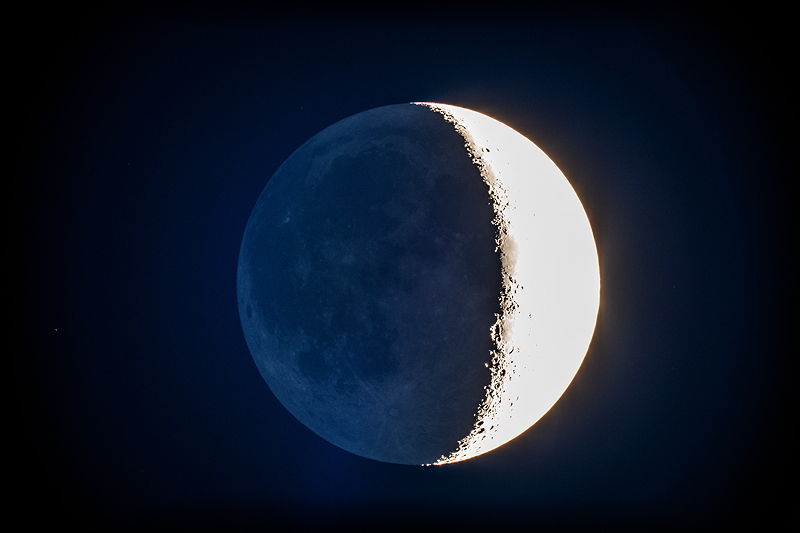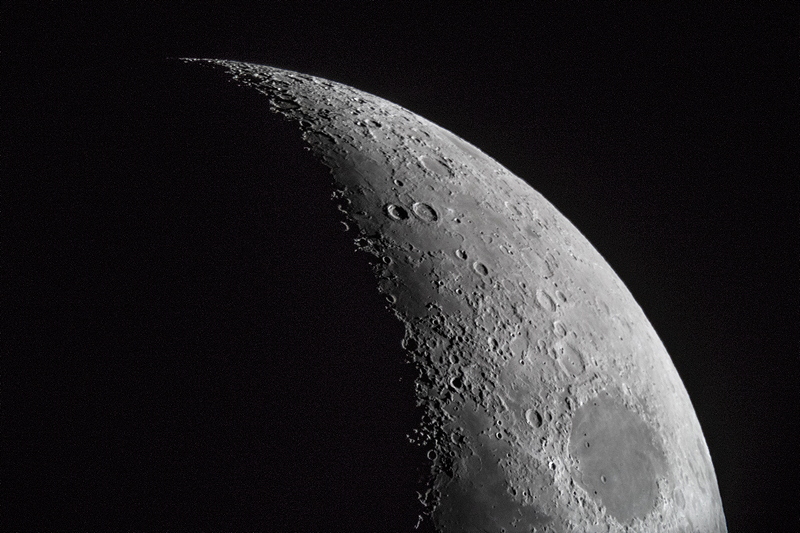D850 DSLR Moon, ISS, Jupiter
Posted: 20 May 2018
A little before heading out to the observatory I took this photo of a local lizard. Check out those sharp claws!

Click or tap on image for larger version
|
Open: Saturday, 19 May 2018, 1905 MST Temperature: 77°F |
Session: 1235 Conditions: Clear |
Equipment Used:
12" f/8 LX600 w/StarLock
2" 24mm UWA eyepiece
2" 9mm 100° eyepiece
Focal Reducer
2" 2X PowerMate
Camera:
D850 DSLR
1921 MST: sunset. LX600 ON, StarLock OFF, High Precision OFF.
Viewed Venus, 102X.
Tweaked finderscope alignment for the night's short pass of the International Space Station (ISS). Then updated the ISS TLE in the AutoStar.
Viewed the Moon, 102X and 271X.
Mounted the D850 DSLR at prime focus + focal reducer for this image of the Moon (1/320sec, ISO 200):

Earthshine (1/4sec, ISO 400):

At the far left is the faint star HD69072, which I would watch get occulted by the Moon later.
Removed the focal reducer and added the 2X PowerMate for these photos (1/250sec, ISO 1600):



Removed the camera and did some lunar terminator observing, 542X. There were some nice views when seeing allowed.
I then began watching the star HD69072 about to be occulted. 202603 MST: occultation.
2036 MST: slewed to the star Regulus and SYNCed the AutoStar for the upcoming ISS pass (start 2102 MST). Mounted the DSLR at prime focus, focused on Regulus, and tweaked the finderscope alignment. 2052 MST: now ready for the ISS pass, or so I thought. When the telescope slewed to begin tracking I discovered that the finderscope eyepiece was not accessible. I had to rotate the finderscope to be able to look through the eyepiece in order to make tracking corrections. Unfortunately that changed the finderscope alignment. How much I had no idea.
I did a D850 DSLR video recording (DX, 2160p, 30fps, 1/2000sec, ISO 3200) for 5m46s. As it turned out the finderscope misalignment put the ISS near the bottom of the frame but there were some frames where it was visible. This was my first use of the D850 DSLR for ISS imaging and the images were underexposed. I was able to get this image of the ISS:

I will use a different shutter speed on the next attempt.
Slewed to Spica, SYNCed, checked the focus, and adjusted the finderscope alignment.
Slewed to Jupiter and did some prime focus video recordings (DX, 2160p, 30fps). This is a stack of 370 video frames (1/800sec, ISO 800):

The Great Red Spot is visible near the left limb of the planet.
2123 MST: ended imaging. Removed the camera from the 12" telescope.
Viewed Jupiter, 102X and 271X. Three moons were visible. The Great Red Spot (no longer very "great") was visible at 271X.
2132 MST: LX600 OFF.
|
Close: Saturday, 19 May 2018, 2141 MST Temperature: 68°F |
Session Length: 2h 36m Conditions: Clear |
Comments are welcome using Email. Twitter users can use the button below to tweet this report to their followers. Thanks.
Cassiopeia Observatory Home Page
Copyright ©2018 Michael L. Weasner / mweasner@me.com
URL = http://www.weasner.com/co/Reports/2018/05/20/index.html
